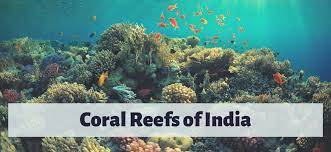Ahmedabad
(Head Office)Address : 506, 3rd EYE THREE (III), Opp. Induben Khakhrawala, Girish Cold Drink Cross Road, CG Road, Navrangpura, Ahmedabad, 380009.
Mobile : 8469231587 / 9586028957
Telephone : 079-40098991
E-mail: dics.upsc@gmail.com

Report on Coral Reefs
News: Global Coral Reef Monitoring Network (GCRMN) has released a report on the status of coral reefs across the world.The report, the first of its kind in 13 years, underlined the catastrophic consequences of global warming but said that some coral reefs can be saved by arresting greenhouse gases.
Details:
• In the last decade, the world lost about 14 per cent of its coral reefs.
• Threats to Corals include Ocean-acidification, warmer sea temperatures and local stressors such as overfishing, pollution, unsustainable tourism and poor coastal management.
• Coral reefs across the world are under relentless stress from warming caused by climate change. Coral bleaching events caused by rise in elevated sea surface temperatures (SST) were responsible for coral loss.
• There has been a steady decrease in hard coral cover in the last four decades since 1978 when the world lost nine per cent of its corals. The decrease is disconcerting because live hard coral cover is an indicator of coral reef health.
• Algal bloom on coral ridges are a sign of stress on the structures. Since 2010, the amount of algae on the world’s coral reefs has increased by about 20 per cent.
• Corals occupy less than one per cent of the ocean floor but over one billion people benefit directly from the reefs.The value of goods and services provided by coral reefs is estimated to be $2.7 trillion per year. This includes $36 billion in coral reef tourism.
• The net economic value of the world’s coral reefs could be nearly tens of billions of dollars per year.
• Persistent rise of land and sea temperatures is a threat to corals.The survival of corals is likely to drop below 50 per cent if sea surface temperatures increase by one degree.All of the world’s reefs will bleach by the end of the century unless the world acts together to reduce carbon emissions.
| What is bleaching? • Basically, bleaching is when the corals expel a certain alga known as zooxanthellae, which lives in the tissues of the coral in a symbiotic relationship.About 90% of the energy of the coral is provided by the zooxanthellae which are endowed with chlorophyll and other pigments.They are responsible for the yellow or reddish brown colours of the host coral. In addition, the zooxanthellae can live as endosymbionts with jellyfish also. • When a coral bleaches, it does not die but comes pretty close to it. Some of the corals may survive the experience and recover once the sea surface temperature returns to normal levels. |

Address : 506, 3rd EYE THREE (III), Opp. Induben Khakhrawala, Girish Cold Drink Cross Road, CG Road, Navrangpura, Ahmedabad, 380009.
Mobile : 8469231587 / 9586028957
Telephone : 079-40098991
E-mail: dics.upsc@gmail.com
Address: A-306, The Landmark, Urjanagar-1, Opp. Spicy Street, Kudasan – Por Road, Kudasan, Gandhinagar – 382421
Mobile : 9723832444 / 9723932444
E-mail: dics.gnagar@gmail.com
Address: 2nd Floor, 9 Shivali Society, L&T Circle, opp. Ratri Bazar, Karelibaugh, Vadodara, 390018
Mobile : 9725692037 / 9725692054
E-mail: dics.vadodara@gmail.com
Address: 403, Raj Victoria, Opp. Pal Walkway, Near Galaxy Circle, Pal, Surat-394510
Mobile : 8401031583 / 8401031587
E-mail: dics.surat@gmail.com
Address: 303,305 K 158 Complex Above Magson, Sindhubhavan Road Ahmedabad-380059
Mobile : 9974751177 / 8469231587
E-mail: dicssbr@gmail.com
Address: 57/17, 2nd Floor, Old Rajinder Nagar Market, Bada Bazaar Marg, Delhi-60
Mobile : 9104830862 / 9104830865
E-mail: dics.newdelhi@gmail.com